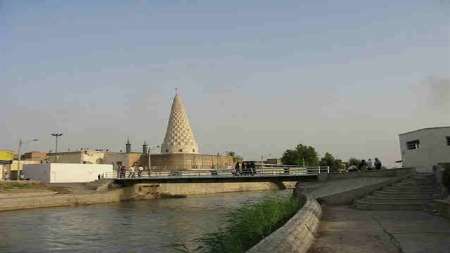
Susa is home to Danial-e Nabi Mausoleum, which has contributed to the city’s prosperity since ancient times by attracting many tourists and pilgrims. Susa is also known as ‘Susa of Daniel’, which is evidence that Prophet Daniel (PBUH) was treated with respect by Susa inhabitants, Tehran-based English newspaper, Iran Daily, reported.
Susa was established in the fifth millennium BCE. Its foundation is regarded as a turning point in the global history of urbanization, according to archeologists.
Susa was founded by the Elamites and settled by Aryans, who founded Median and Achaemenid empires, respectively. Susa was one of the three capital cities of the Achaemenids. While Persepolis and Hegmataneh were regarded as their seasonal capital, Susa was more permanent.
Susa was a flourishing city during the Seljuk, Parthian and Sassanid eras. However, the Mongol invasion laid the city to ruins.
After the Mongol invasion, Susa was in total ramshackle with huge hills that had embraced world’s most precious heritages.
The French were the first archeologists to excavate the city in the late 19th century. Their studies shed the light on Iran’s ancient history and raised global knowledge about the first civilizations that emerged in Iran. However, their activities paved the ground for pillagers and illegal diggers as well. Many valuable artifacts were taken abroad by foreign archeologists to be kept at the word’s most prestigious museums.
Persian Daily ‘Iran’ has mentioned some of the most important historical sites of Susa as follows:
Danial-e Nabi Mausoleum
Danial-e Nabi Mausoleum, tomb of Prophet Daniel (PBUH), can be regarded as the most important tourism attractions of Susa. The tomb with a tall and conical dome is the most distinctive landmark of this ancient city.
Living in the seventh century BCE, Prophet Daniel (PBUH) and his Jewish followers, were captivated by the Neo-Babylonian Empire, Nebuchadnezzar.
They were released and immigrated to Susa, after the prophet interpreted one of Nebuchadnezzar’s dreams.
Prophet Daniel (PBUH) lived in Susa, which was a rural region then, until he passed away.
The tomb of Prophet Daniel (PBUH) has been respected by the visitors to Susa as well as the residents of Khuzestan province since ancient times.
His tomb was the first historical site registered on National Heritage List 84 years ago.
Acropolis Hill
There are numerous ancient constructions in the vicinity of Susa. Dating back to an era between several centuries BCE and Mid-Islamic era, all of these constructions have been registered on the UNESCO World Heritage List.
Acropolis Hill is one of the most important historical sites of Susa. It is located near the tomb of Prophet Daniel (PBUH), overlooking the city.
Twenty-seven historical layers attributing to Elamite, Achaemenid, Parthian, Sassanid and Islamic eras, have been identified in the hill. The most important remains of global civilizations such as Hammurabi Code have been unearthed from the hill.
French archeologists who had arrived to conduct excavations in the ancient city of Susa during Qajar era, built a tall castle on top of the Acropolis Hill — ‘Acropolis Castle’ — using Elamite bricks that had been unearthed in the vicinity of Susa. One can view the entire city from top of the castle.
There is a garden in front of the castle, which is home to Susa’s Archeological Museum, showcasing the remaining artifacts, which French archeologists could not smuggle out to their country.
Apadana Palace
The remnants of a winter palace, Apadana, were uncovered near Acropolis Hill by archeologists. Established by Achaemenid King Darius I, the palace dates back to between 521 and 551 CE.
Apadana Palace spreads over an area of 10,000 sq.m. The important artifacts including capitals of column featuring heads of cows, are kept at Louvre Museum.
Shavoor Palace
Shavoor Palace is situated near a river with similar name. It dates back to the rule of Achaemenid King Ardeshir II.
It was not until 46 years ago that the palace was discovered following a construction project.
Dabal Khazaei Tomb
Dabal Khazaei, is Susa’s second important pilgrimage site after the tomb of Prophet Daniel (PBUH). Dabal was a prominent Arab poet during the Abbasid era — eighth and ninth centuries CE. Dabal was one of the supporters of Imam Reza (PBUH), the eighth Shia Imam. He was respected by Susa inhabitants because of his religious beliefs.
Choghazanbil Ziggurat
Choghazanbil has been acknowledged as Iran’s oldest temple. It was built more than 3,300 years ago. Choghazanbil was the first Iranian ancient monument registered on World Heritage List in 1980.
More than one million pieces of bricks have been used for building Choghazanbil, which rests between Dez and Karkheh rivers.
Ziggurats were Elamite structures symbolizing ascension to heaven.
Choghazanbil Ziggurat is a five-storey structure with a height of about 52 meters.
The ziggurat was accidentally discovered in the late nineteenth century and excavated by French archeologists in a project that lasted about 11 years.
The tombs of Elamite kings have also been identified near the ziggurat.
Haft Tappeh
The historical field of Haft Tappeh is located 15 kilometers to the southeast of Susa, in the middle of sugarcane farms.
The site dates back to the first millennium BCE. Many artifacts have been unearthed in the site, which are now kept at museums in Iran.
Ivan-e Karkheh
Ivan-e Karkheh is an ancient palace, which was constructed by Sassanid King, Shapour II. Built about 1,700 years ago, the ancient city and the palace were severely damaged during the 1980-88 Iraqi-imposed war.
Tourism facilities, souvenirs
In spite of having lots of tourism attractions, Susa lacks tourism facilities. Susa only has a one-star hotel. Those traveling to Khuzestan province, have to stay in hotels in Ahvaz, which is far from Susa.
Pottery is the most important souvenir of Susa. The history of pottery making dates back to 7,000 years.
Straw baskets, made of palm leaves, are other souvenirs of the city.
Once the number of hotels increases and transportation facilities improve, Susa will attract the largest numbers of tourists, which will contribute to its economy.

Add new comment